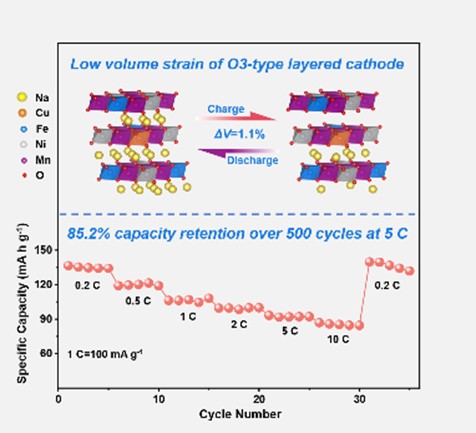Cu and Fe doping realized high rate and low volume strain O3-type layered oxide cathode for sodium ion batteries

Abstract
O3-type layered oxides are promising cathode materials for sodium-ion batteries (SIBs). However, their application is limited by tortuous Na+ diffusion channels and complex phase transitions. In this study, a high-rate, low-volume-strain O3-Na0.9Cu0.05Fe0.15Ni0.25Mn0.55O2 (CFNM) cathode is synthesized using a Cu and Fe doping strategy. Multiple characterization techniques and density functional theory (DFT) calculations demonstrate that co-doping modulates the TM-O (transition metal-oxygen) and Na-O bond interactions, expanding Na+ diffusion channels and reducing diffusion energy barriers; the co-doping also promotes electron localization within the TM layers, alters the Na+ deintercalation sequence, and mitigates structural degradation, thereby facilitating rapid and reversible O3-P3 phase transitions without monoclinic phase transitions. The lattice parameter changes exhibit characteristics similar to those of a solid solution, featuring a minimal volume change of 1.1%. Consequently, CFNM delivers a specific capacity of 85.5 mA h g-1 at 10 C and retains 85.2% capacity after 500 cycles at 5 C. Additionally, the full cell assembled with hard carbon (HC) achieves an energy density of 322.8 Wh kg-1 and retains 76.4% capacity after 200 cycles at 1 C. Excellent air stability further demonstrates the practical applicability of CFNM. This study provides new insights into the development of high-performance cathode materials for SIBs.

